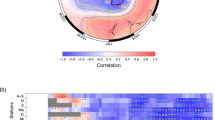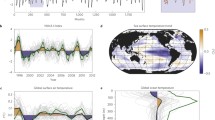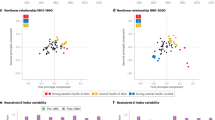Abstract
The leading mode of southern hemisphere (SH) climatic variability, the southern annular mode (SAM), has recently seen a shift towards its positive phase due to stratospheric ozone depletion and increasing greenhouse gas (GHG) concentrations. Here we examine how sensitive the SAM (defined as the leading empirical orthogonal function of SH sea level pressure anomalies) is to future GHG concentrations. We determine its likely evolution for three intergovernmental panel on climate change (IPCC) special report on emission scenarios (SRES) for austral summer and winter, using a multi-model ensemble of IPCC fourth assessment report models which resolve stratospheric ozone recovery. During the period of summer ozone recovery (2000–2050), the SAM index exhibits weakly negative, statistically insignificant trends due to stratospheric ozone recovery which offsets the positive forcing imposed by increasing GHG concentrations. Thereafter, positive SAM index trends occur with magnitudes that show sensitivity to the SRES scenario utilised, and thus future GHG emissions. Trends are determined to be strongest for SRES A2, followed by A1B and B1, respectively. The winter SAM maintains a similar dependency upon GHG as summer, but over the entire twenty-first century and to a greater extent. We also examine the influence of ozone recovery by comparing results to models that exclude stratospheric ozone recovery. Projections are shown to be statistically different from the aforementioned results, highlighting the importance of ozone recovery in governing SAM-evolution. We therefore demonstrate that the future SAM will depend both upon GHG emissions and stratospheric ozone recovery.








Similar content being viewed by others
Notes
After submitting the original manuscript we learnt about the study by Paeth and Pollinger (2010) who arrived at similar conclusions to those of the present study.
References
Arblaster JM, Meehl GA (2006) Contributions of external forcings to southern annular mode trends. J Clim 19(12):2896–2905
Arblaster JM, Meehl GA, Karoly DJ (2011) Future climate change in the southern hemisphere: competing effects of ozone and greenhouse gases. Geophys Res Lett 38. doi:10.1029/2010gl045384
Cai WJ, Cowan T (2007) Trends in southern hemisphere circulation in IPCC AR4 models over 1950–99: ozone depletion versus greenhouse forcing. J Clim 20(4):681–693. doi:10.1175/jcli4028.1
Cai WJ, Whetton PH, Karoly DJ (2003) The response of the antarctic oscillation to increasing and stabilized atmospheric CO2. J Clim 16(10):1525–1538
Ciasto LM, Thompson DWJ (2008) Observations of large-scale ocean–atmosphere interaction in the southern hemisphere. J Clim 21(6):1244–1259. doi:10.1175/2007jcl11809.1
Eyring V, Waugh DW, Bodeker GE, Cordero E, Akiyoshi H, Austin J, Beagley SR, Boville BA, Braesicke P, Bruhl C, Butchart N, Chipperfield MP, Dameris M, Deckert R, Deushi M, Frith SM, Garcia RR, Gettelman A, Giorgetta MA, Kinnison DE, Mancini E, Manzini E, Marsh DR, Matthes S, Nagashima T, Newman PA, Nielsen JE, Pawson S, Pitari G, Plummer DA, Rozanov E, Schraner M, Scinocca JF, Semeniuk K, Shepherd TG, Shibata K, Steil B, Stolarski RS, Tian W, Yoshiki M (2007) Multimodel projections of stratospheric ozone in the 21st century. J Geophys Res Atmos 112(D16). doi:10.1029/2006jd008332
Fogt RL, Perlwitz J, Monaghan AJ, Bromwich DH, Jones JM, Marshall GJ (2009) Historical sam variability. Part II: Twentieth-century variability and trends from reconstructions, observations, and the IPCC AR4 models. J Clim 22(20):5346–5365. doi:10.1175/2009jcli2786.1
Fyfe JC, Boer GJ, Flato GM (1999) The arctic and antarctic oscillations and their projected changes under global warming. Geophys Res Lett 26(11):1601–1604
Gillett NP, Thompson DWJ (2003) Simulation of recent southern hemisphere climate change. Science 302(5643):273–275
Gillett NP, Zwiers FW, Weaver AJ, Hegerl GC, Allen MR, Stott PA (2002) Detecting anthropogenic influence with a multi-model ensemble. Geophys Res Lett 29(20). doi:10.1029/2002gl015836
Gong DY, Wang SW (1999) Definition of antarctic oscillation index. Geophys Res Lett 26(4):459–462
Hendon HH, Thompson DWJ, Wheeler MC (2007) Australian rainfall and surface temperature variations associated with the southern hemisphere annular mode. J Clim 20(11):2452–2467. doi:10.1175/jcli4134.1
Jones JM, Widmann M (2003) Instrument- and tree-ring-based estimates of the antarctic oscillation. J Clim 16(21):3511–3524
Jones JM, Widmann M (2004) Atmospheric science—early peak in antarctic oscillation index. Nature 432(7015):290–291. doi:10.1038/432290b
Jones JM, Fogt RL, Widmann M, Marshall GJ, Jones PD, Visbeck M (2009) Historical sam variability. Part I: Century-length seasonal reconstructions. J Clim 22(20):5319–5345. doi:10.1175/2009jcli2785.1
Karpechko AY, Gillett NP, Marshall GJ, Scaife AA (2008) Stratospheric influence on circulation changes in the southern hemisphere troposphere in coupled climate models. Geophys Res Lett 35(20). doi:10.1029/2008gl035354
Karpechko AY, Gillett NP, Marshall GJ, Screen JA (2009) Climate impacts of the southern annular mode simulated by the CMIP3 models. J Clim 22(13):3751–3768. doi:10.1175/2009jcli2788.1
Karpechko AY, Gillett NP, Gray LJ, Dall’Amico M (2010) Influence of ozone recovery and greenhouse gas increases on southern hemisphere circulation. J Geophys Res Atmos 115. doi:10.1029/2010jd014423
Kushner PJ, Held IM, Delworth TL (2001) Southern hemisphere atmospheric circulation response to global warming. J Clim 14(10):2238–2249
Lefebvre W, Goosse H, Timmermann R, Fichefet T (2004) Influence of the southern annular mode on the sea ice-ocean system. J Geophys Res Oceans 109(C9). doi:10.1029/2004jc002403
Marshall GJ (2003) Trends in the southern annular mode from observations and reanalyses. J Clim 16(24):4134–4143
Marshall GJ (2007) Half-century seasonal relationships between the southern annular mode and antarctic temperatures. Int J Climatol 27(3):373–383. doi:10.1002/joc.1407
Marshall GJ, Orr A, van Lipzig NPM, King JC (2006) The impact of a changing southern hemisphere annular mode on antarctic peninsula summer temperatures. J Clim 19(20):5388–5404
Meehl GA, Stocker TF, Collins WD, Friedlingstein P, Gaye AT, Gregory JM, Kitoh A, Knutti R, Murphy JM, Noda A, Raper SCB, Watterson IG, Weaver AJ, Zhao Z-C (2007) Global climate projections. In: Solomon S, Qin D, Manning M, Chen Z, Marquis M, Averyt KB, Tignor M, Miller HL (eds) Climate change 2007: the physical science basis.Contribution of working group I to the fourth assessment report of the intergovernmental panel on climate change. Cambridge University Press, Cambridge and New York, NY
Miller RL, Schmidt GA, Shindell DT (2006) Forced annular variations in the 20th century intergovernmental panel on climate change fourth assessment report models. J Geophys Res Atmos 111(D18). doi:10.1029/2005jd006323
Nakicenovic N, Alcamo J, Davis G, de Vries B, Fenhann J, Gaffin S, Gregory K, Grubler A, Jung TY, Kram T, La Rovere EL, Michaelis L, Mori S, Morita T, Pepper W, Pitcher HM, Price L, Riahi K, Roehrl A, Rogner H-H, Sankovski A, Schlesinger M, Shukla P, Smith SJ, Swart R, van Rooijen S, Victor N, Dadi Z (2000) Special report on emissions scenarios: a special report of working group III of the intergovernmental panel on climate change. Other information: Pbd: 3 Oct 2000
Paeth H, Pollinger F (2010) Enhanced evidence in climate models for changes in extratropical atmospheric circulation. Tellus Ser A Dyn Meteorol Oceanol 62(5):647–660. doi:10.1111/j.1600-0870.2010.00455.x
Perlwitz J, Pawson S, Fogt RL, Nielsen JE, Neff WD (2008) Impact of stratospheric ozone hole recovery on antarctic climate. Geophys Res Lett 35(8). doi:10.1029/2008gl033317
Polvani LM, Previdi M, Deser C (2011) Large cancellation, due to ozone recovery, of future southern hemisphere atmospheric circulation trends. Geophys Res Lett 38. doi:10.1029/2011gl046712
Reason CJC, Rouault M (2005) Links between the antarctic oscillation and winter rainfall over western South Africa. Geophys Res Lett 32(7). doi:10.1029/2005gl022419
Sen Gupta A, England MH (2006) Coupled ocean–atmosphere-ice response to variations in the southern annular mode. J Clim 19(18):4457–4486
Shindell DT, Schmidt GA (2004) Southern hemisphere climate response to ozone changes and greenhouse gas increases. Geophys Res Lett 31(18). doi:10.1029/2004gl020724
Silvestri GE, Vera CS (2003) Antarctic oscillation signal on precipitation anomalies over southeastern South America. Geophys Res Lett 30(21). doi:10.1029/2003gl018277
Solomon S, Portmann RW, Sasaki T, Hofmann DJ, Thompson DWJ (2005) Four decades of ozonesonde measurements over Antarctica. J Geophys Res Atmos 110(D21). doi:10.1029/2005jd005917
Son SW, Polvani LM, Waugh DW, Akiyoshi H, Garcia R, Kinnison D, Pawson S, Rozanov E, Shepherd TG, Shibata K (2008) The impact of stratospheric ozone recovery on the southern hemisphere westerly jet. Science 320(5882):1486–1489. doi:10.1126/science.1155939
Son SW, Tandon NF, Polvani LM, Waugh DW (2009) Ozone hole and southern hemisphere climate change. Geophys Res Lett 36. doi:10.1029/2009gl038671
Son SW, Gerber EP, Perlwitz J, Polvani LM, Gillett NP, Seo KH, Eyring V, Shepherd TG, Waugh D, Akiyoshi H, Austin J, Baumgaertner A, Bekki S, Braesicke P, Bruhl C, Butchart N, Chipperfield MP, Cugnet D, Dameris M, Dhomse S, Frith S, Garny H, Garcia R, Hardiman SC, Jockel P, Lamarque JF, Mancini E, Marchand M, Michou M, Nakamura T, Morgenstern O, Pitari G, Plummer DA, Pyle J, Rozanov E, Scinocca JF, Shibata K, Smale D, Teyssedre H, Tian W, Yamashita Y (2010) Impact of stratospheric ozone on southern hemisphere circulation change: a multimodel assessment. J Geophys Res Atmos 115. doi:10.1029/2010jd014271
Stone DA, Weaver AJ, Stouffer RJ (2001) Projection of climate change onto modes of atmospheric variability. J Clim 14(17):3551–3565
Thompson DWJ, Solomon S (2002) Interpretation of recent southern hemisphere climate change. Science 296(5569):895–899
Thompson DWJ, Solomon S (2005) Recent stratospheric climate trends as evidenced in radiosonde data: global structure and tropospheric linkages. J Clim 18(22):4785–4795
Thompson DWJ, Wallace JM (2000) Annular modes in the extratropical circulation. Part I: Month-to-month variability. J Clim 13(5):1000–1016
Turner J, Colwell SR, Marshall GJ, Lachlan-Cope TA, Carleton AM, Jones PD, Lagun V, Reid PA, Iagovkina S (2005) Antarctic climate change during the last 50 years. Int J Climatol 25(3):279–294
Waugh DW, Oman L, Newman PA, Stolarski RS, Pawson S, Nielsen JE, Perlwitz J (2009) Effect of zonal asymmetries in stratospheric ozone on simulated southern hemisphere climate trends. Geophys Res Lett 36. doi:10.1029/2009gl040419
Yin JH (2005) A consistent poleward shift of the storm tracks in simulations of 21st century climate. Geophys Res Lett 32(18). doi:10.1029/2005gl023684
Acknowledgments
This work was funded, in part, by a NERC Postgraduate Masters Studentship. AK was funded by NERC Project NE/E006787/1 and by the Finnish Academy. We acknowledge the modelling groups, the Program for Climate Model Diagnosis and Intercomparison (PCMDI) and the WCRP’s Working Group on Coupled Modelling (WGCM) for their role in making the WCRP CMIP3 multi-model dataset available. The authors thank the anonymous reviewer for their constructive comments which improved this manuscript, and Dr. Laura Ciasto for insightful discussions of results.
Author information
Authors and Affiliations
Corresponding author
Rights and permissions
About this article
Cite this article
Simpkins, G.R., Karpechko, A.Y. Sensitivity of the southern annular mode to greenhouse gas emission scenarios. Clim Dyn 38, 563–572 (2012). https://doi.org/10.1007/s00382-011-1121-2
Received:
Accepted:
Published:
Issue Date:
DOI: https://doi.org/10.1007/s00382-011-1121-2




